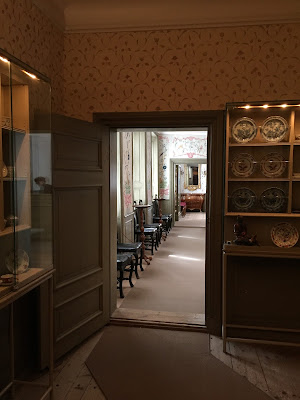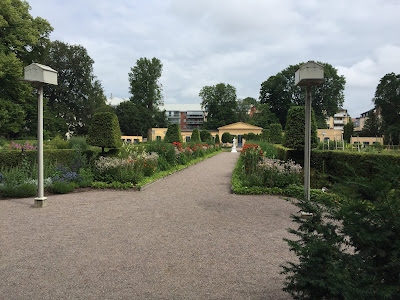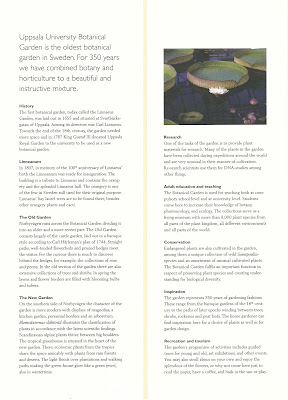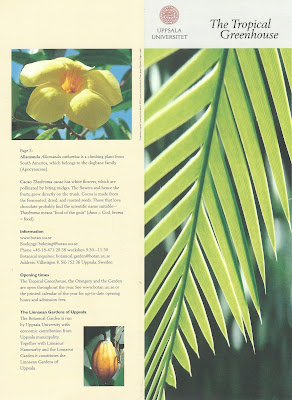Overview



Left: The Linnaeus Museum in Uppsala. Center: Main axis of the Linnaeus Garden. Right: Aquarium lacustre - lake pond and orangery.
Four years ago I started to get interested in Carl Linnaeus (1707 – 1778), often referred to as the “father of modern taxonomy", and his work on the naming of plants, first described in Systema naturae (1735). I read Linnaeus: The Compleat Naturalist for some background; it's a biography of Linnaeus that was first published in 1971. The biography makes a number of references to the Linnaeus Garden in Uppsala, and so it was fitting that when we were recently in Stockholm Sweden, we should make a trip north to Uppsala.
It’s easy to get to Uppsala by train from Stockholm’s main station. Arriving at the train station in Uppsala, it’s a easy and pleasant walk through the town to reach the garden.
Visiting the garden includes visiting the Linnaeus Museum, the home Linnaeus lived in between 1743 and 1778. It takes a good 30 to 60 minutes to explore the house, depending on your interest. The free audio guide is useful for making sense of the rooms and artifacts found therein. The museum naturally talks about Linnaeus but also a lot about his wife Sara Elisabeth Moræa* (1716 – 1806). They were married from 1739 until Linnaeus’ death and had seven children. Sara Lisa seems to have been quite a capable woman, running the house and the family business as many good Swedish housewives did back then…as the audio guide informed us.
Aside: I’ve always been confused with the multiple names used to refer to Linnaeus, the man who revolutionized the naming of things. In English and Swedish, his name is Carl Linnaeus. Linnaeus wrote a lot in Latin, and his name Latinized is Carolus Linnæus (with the grapheme æ). Carl von Linné is the name he took after being ennobled in 1761 (ante-dated 1757), with the addition of the nobiliary particle von. And finally, I have to remember when talking to my Italian friends that he’s known as Carlo Linneo.




The Linnaeus Museum. Left: First floor. Center left: Second floor. Center right: Bedroom with showcase of manuscripts authored by Linnaeus. Right: View from the museum into the garden.
After visiting the house, we strolled around the gardens, which are today restored more or less as they were in Linnaeus’ time circa 1745. That wasn’t always the case. The gardens fell into disuse and the house was used for other purposes for over a hundred years after Linnaeus' death. It was the Swedish Linnaeus Society founded in 1917 who is to credit for the resurrection of the gardens and house to the state we see it today.
Curiosity: The Linnaeus family kept a small menagerie of animals around them while they lived in Uppsala including a raccoon, Guinea pigs, peacocks, parrots, and monkeys. While visiting the Linnaeus garden, you can’t help but notice the monkey houses, small gray huts placed high on poles. They have an interesting chain system so that monkeys could go up and down the poles but always remained attached.
Sexual System
How are the gardens arranged? From the garden brochure (attached below) we have these major sections:
- Perennial parterre with perennial species planted according to the 24 classes in the Linnaeus’ classification.
- Annual parterre with annual and biennial species. There are 44 beds including annual and biennial plants.
- Apricarium where succulents are kept during summers.
- Aquarium fluviatile simulating a river pond setting.
- Aquarium lacustre simulating a lake pond setting.
- Aquarium palustre simulating a marsh pond.
Spring parterre with Siberian plants and spring-flowering bulbs. - Autumn parterre with plants from eastern North America.
- Southern parterre where plants from the orangery are placed during the summer.
- The hedges surrounding the perennial and annual parterres are a mix of mock orange, barberry, willow and spruce.
We spent the most time looking at the plants in the annual and perennial parterres, which are arranged according to the 24 classes in Linnaeus’ sexual system. Sexual what? Linnaeus had a strong penchant for order and a dissatisfaction with existing plant classification systems, so he invented his own based on the arrangement and number of male and female parts of the flowers of plants, his so-called sexual system. Recall that Linnaeus lived before Darwin and the ideas of evolutionary relationships between individual and groups of organisms such as plant species were yet to come.
Linnaeus’ system was based on observable similarities, not natural relationships between plants. Though, at times observable similarities (or artificial relationships) are related to an underlying natural relationship. In fact, as we explored the two parterres, initially I thought the plants were arranged by (what we call today) families because that’s how I first perceived the groupings of plants. However, after poking around a bit, this didn’t quite make sense.
It turns out that there is some overlap between Linnaeus’ classification and the modern taxonomic rank of family. For example, Class II:1 (Diandria) contains Olea, Ligustrum, Syringa and Jasminum, which today are all grouped in the family Oleaceae. On the other hand, Class II:1 (Diandria) also contains Veronica, Justicia, Pinguicula, and Verbena which are in different families, respectively Plantaginaceae, Acanthaceae, Lentibulariaceae, and Verbenaceae.



Left: View of main axis of the Linnaeus Garden. Center the hedge around the perennial parterre. Right: View of monkey huts.
Selected Plants
When Linnaeus took over responsibility for the garden in 1741, he re-arranged it according to his classification scheme and documented it in Hortus Upsaliensis (1748).
The plants listed below are a few we photographed in the annual and perennial parterres. They are listed in order by parterre, and their Linnaeus class, 1 through 24. For an idea of the original class descriptions, see the 10th edition of Systema Naturae (volume 2) available at the Biodiversity Heritage Library web site. For example, for class 9 (IX), Enneandria, the Latin description is “Mariti novem in eodem thalamo cum femina”, which can be translated as “Nine men in the same bride’s chamber, with one woman”. Pretty saucy stuff.
Name from plant label in Linnaeus’ Garden
- Class:Order in Linnaeus’ system, e.g., II:2 is called Diandria, flowers with 2 stamens and 1 pistil
- Location: annual or perennial parterre
- Today’s accepted family name
- II:1 - Diandria:Monogynia
- Location: perennial parterre
- Family: Plantaginaceae


Anchusa officinalis
- V:1 - Pentandria:Monogynian
- Location: perennial parterre
- Family: Boraginaceae


Symphutum officinale
- V:1 - Pentandria:Monogynian
- Location: perennial parterre
- Family: Boraginaceae


Astrantia major
- V:2 - Pentandria:Digynia
- Location: perennial parterre
- Family: Apiaceae


Asclepias syriaca
- V:2 - Pentandria:Digynia
- Location: perennial parterre
- Family: Asclepiadaceae


Linum perenne
- V:5 - Pentandria:Pentagynia
- Location: perennial parterre
- Family: Linaceae


Tradescantia virginiana
- VI:1 - Hexandria:Monogynia
- Location: perennial parterre
- Family: Commelinaceae

Rheum palmatum
- IX:2 - Enneandria:Monogynia
- Location: perennial parterre
- Family: Polygonaceae


Eryngium planum
- X:II -
- Location: perennial parterre
- Family: Apiaceae


Lychnis chalcedonica
- X:5 - Decandria:Pentagynia
- Location: perennial parterre
- Family: Caryophyllaceae


Delphinium elatum
- XIII:3 0 Polyandria:Trigynia
- Location: perennial parterre
- Family: Ranunculaceae


Phlomis tuberosa
- XIV:1 - Didynamia:Gymnospermia
- Location: perennial parterre
- Family: Lamiaceae


Digitalis lutea
- XIV:2 - Didynamia:Angiospermia
- Location: perennial parterre
- Family: Plantaginaceae


Anthyllis vulneraria
- XVII:4 - Diadelphia:Decandria
- Location: perennial parterre
- Family: Fabiaceae


Sonchus plumieri
- XIX:1 - Syngenesia:Polygami Æqualis
- Location: perennial parterre
- Family: Asteraceae
- Synonym of Lactuca plumieri


Tagetes patula
- XIX:2 - Syngenesia:Superflua
- Location: perennial parterre
- Family: Asteraceae


Salvia sclarea
- II:1
- Location: annual parterre
- Family: Lamiaceae


Convolvulus tricolor
- V:1 - Diandria:Monogynia
- Location: annual parterre
- Family: Convulvulaceae


Hyoscyamus niger
- V:1: Pentandria:Monogynia
- Location: annual parterre
- Family: Solanaceae


Echium vulgare
- V:1 - Pentandria:Monogynia
- Location: annual parterre
- Family: Boraginaceae

Browallia americana
- XIV:2 - Didynamia:Angiospermia
- Location: annual parterre
- Family: Solanaceae

Ricinus communis
- XX1:9 - Monoecia:Monadelphia
- Location: annual parterre
- Family: Euphorbiaceae


Brochures
Other associated Linnaeus-themed stops you might consider while in Uppsala are:
- Linnaeus’ Hammarby. This was Linnaeus’ summer residence. Sara Lisa managed the house and farm while Linnaeus worked on naming things. Hammarby is just outside of Uppsala to the southeast.
- The Botanical Garden (Uppsala University). Today this is the official botanical garden, created in 1787 after Linnaeus garden became too small to meet the needs of the university. The botanical garden is about a 20-minute walk from the Linnaeus Garden.



The Linnaeus Museum brochure.



The Linnaeus Garden Brochure.



Linnaeus Hammarby Brochure.



The Botanical Garden Brochure.



The Tropical Greenhouse Brochure.
No comments:
Post a Comment
All comments are moderated. If your comment doesn't appear right away, it was likely accepted. Check back in a day if you asked a question.